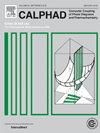预测混合氧化物标准生成焓和熵的改进多面体模型
IF 1.9
3区 材料科学
Q4 CHEMISTRY, PHYSICAL
Calphad-computer Coupling of Phase Diagrams and Thermochemistry
Pub Date : 2025-06-26
DOI:10.1016/j.calphad.2025.102848
引用次数: 0
摘要
氧化系统的热力学建模对于推动各个科学技术领域的发展至关重要。多面体模型(Polyhedron Model, PM)通过对组成多面体的热力学性质的线性求和来估计混合氧化物的标准生成焓和熵。每个多面体由一个中心阳离子和邻近的氧阴离子组成;因此,该模型解释了阴离子和阳离子之间的相互作用。虽然在以前的模型迭代中已经考虑了二阶过渡,但PM有一定的缺点,包括忽略多面体体积的变化、多面体畸变、多面体间的连接以及第二近邻或高阶相互作用,这些都是不可忽略的。本研究引入了修正多面体模型(MPM),该模型旨在通过神经网络(NN)模型整合这些贡献,以提高标准生成焓(ΔH298Ko)和标准熵(S298Ko)预测的准确性。这可以通过使用PM的残差作为NN模型的输入来实现,NN模型的输出是计算出的化合物的热力学性质。该数据集由Li-Na-K-Ca-Mg-Mn-Fe-Al-Ti-Si-O体系中的155种化合物组成,按20个多面体分类。与PM相比,MPM大大减少了预测生成焓和熵的误差,提高了大多数分析化合物与实验值的一致性。这些结果表明,MPM可以显著提高混合氧化物热力学性质的可预测性。本文章由计算机程序翻译,如有差异,请以英文原文为准。
Modified polyhedron model for predicting standard enthalpy of formation and entropy of mixed oxides
Thermodynamic modeling of oxidic systems is crucial in advancing various fields of science and technology. Polyhedron Model (PM) estimates the standard enthalpy of formation and entropy of mixed oxides via the linear summation of the thermodynamic properties of constituent polyhedra. Each polyhedron consists of a centered cation with neighboring oxygen anions; hence, the model accounts for the interaction between anions and cations. While second-order transitions have been considered in previous iterations of the model, the PM has certain shortcomings, including neglect of variations in polyhedron volume, polyhedron distortion, inter-polyhedron linkage, and second nearest-neighbor or higher-order interactions, which are not negligible. The present work introduces the Modified Polyhedron Model (MPM), which aims to incorporate these contributions through a neural network (NN) model to improve the accuracy of predictions for standard enthalpy of formation () and standard entropy (). This is possible by using the residuals from the PM as inputs to the NN model, whose outputs are the calculated thermodynamic properties of compounds. The dataset consists of 155 compounds in the Li-Na-K-Ca-Mg-Mn-Fe-Al-Ti-Si-O system, classified by 20 polyhedra. The MPM considerably reduces the error in predicting enthalpy of formation and entropy, improving the alignment with experimental values across most analyzed compounds in comparison with the PM. These results suggest that the MPM can significantly improve the predictability of thermodynamic properties for mixed oxides.
求助全文
通过发布文献求助,成功后即可免费获取论文全文。
去求助
来源期刊
CiteScore
4.00
自引率
16.70%
发文量
94
审稿时长
2.5 months
期刊介绍:
The design of industrial processes requires reliable thermodynamic data. CALPHAD (Computer Coupling of Phase Diagrams and Thermochemistry) aims to promote computational thermodynamics through development of models to represent thermodynamic properties for various phases which permit prediction of properties of multicomponent systems from those of binary and ternary subsystems, critical assessment of data and their incorporation into self-consistent databases, development of software to optimize and derive thermodynamic parameters and the development and use of databanks for calculations to improve understanding of various industrial and technological processes. This work is disseminated through the CALPHAD journal and its annual conference.

 求助内容:
求助内容: 应助结果提醒方式:
应助结果提醒方式:


